Dorothy Gray (1930-1945)
Continued from: Dorothy Gray
Continued onto: Dorothy Gray (post 1945)
During the 1930s, Lehn & Fink built Dorothy Gray up to become one of the three most successful salon-based cosmetic companies in the United States, the others being Helena Rubinstein and Elizabeth Arden. Dorothy Gray stayed on with Lehn & Fink for a short time after the buyout and her image was used in some advertising in the late 1920s. However, this was soon dropped and, by the 1930s, all that remained of Dorothy Gray, the person, was her name and initials.
The success of Dorothy Gray was not due to product innovation as, with few exceptions, it followed trends rather than setting them. However, like Helena Rubinstein and Elizabeth Arden, the company had a solid product line, an extensive stable of salons, was New York based, and advertised extensively.
Lehn & Fink began adding new Dorothy Gray salons across the United States in the 1920s and this continued in the 1930s. Dorothy Gray services were also installed on some ships of the Grace Line and the American Republics Line – with the first ship-board salon installed on the S.S. Santa Rosa of the Grace line in 1932.
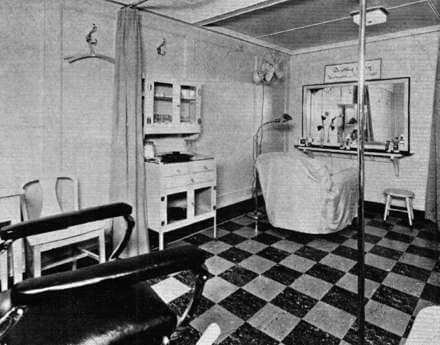
Above: 1933 A Dorothy Gray ship-board salon on the ‘Santa Rosa’. It appears to be sharing space with a hairdressing salon but could be made more private with a curtain.
Lehn & Fink also began opening Dorothy Gray salons overseas starting with France. In 1930, Dorothy Gray (France) S.A., capital 200,000 Fr, was founded in Paris and, soon after, a salon was opened at 34 Avenue George V.
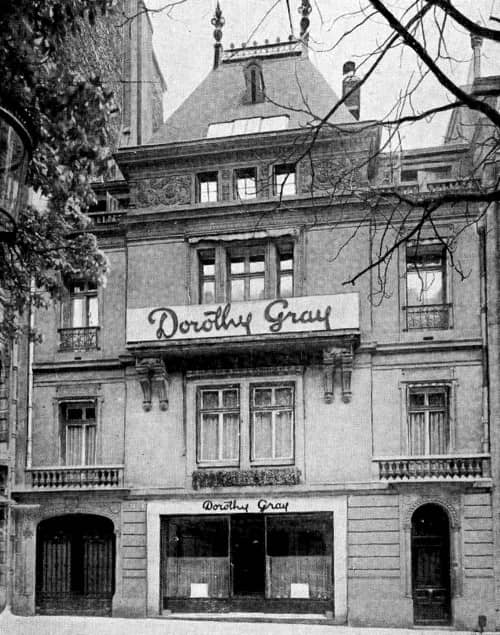
Above: The Dorothy Gray Salon at 34 Avenue George V, Paris, first opened in 1930. It was managed by Wendy Mayhew; therapists were French and Russian but all spoke English.
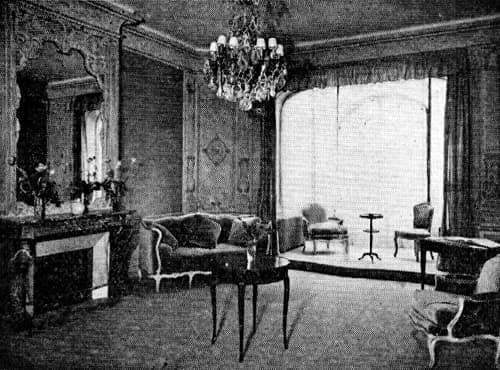
Above: 1930 Reception in the Dorothy Gray salon in Paris.
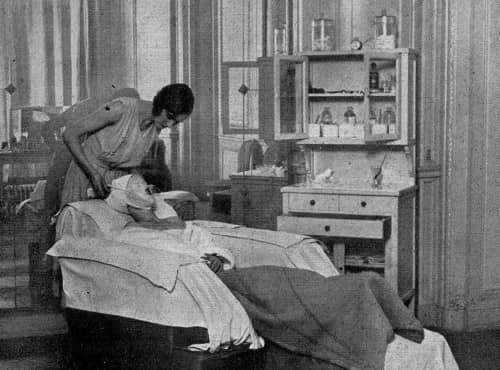
Above: 1932 Treatment room in the Dorothy Gray Paris salon.
Dorothy Gray Ltd. (Britain), capital £1,000, was organised in London in 1936 with a salon opened in Hanover Square as part of Francis Coiffure de Dames. Other Dorothy Gray salons opened in Europe in the 1930s included Brussels, Stockholm, Amsterdam, The Hague, Rotterdam, Marseilles, Nice, Monte Carlo, and Cannes.
Salon treatments
There was little change in the Dorothy Gray salon treatments in the 1930s until 1938 when an exercise department was added on the fourth floor of the New York salon, something Helena Rubinstein and Elizabeth Arden were also doing. New figure treatments were added and now included body sculpting through massage, half-hour treatments with heated pads called blanquettes, half-hour general exercise routines, and half-hour sessions of squash.
Body Massage: A soothing relaxation. Skilled fingers help slim you down or build you up— according to your needs.
Blanquette: Heated body pads designed to help you slough off unwanted pounds, reduce you in sports.
Exercise:Limbering, stretching . . . stooping. swooping—all with the divine purpose of remoulding your figure, correcting your posture.
Squash Racquets: Under the expert supervision of a master, to enhance body suppleness.(Dorothy Gray advertisement, 1939)
Other services included: planned diets, body styling luncheons, colonic irrigations, sun-lamp treatments, posture correction, and voice training.
In 1940, Dorothy Gray combined class and personal instruction in food principles, diets, exercise, make-up and grooming, posture, diction, and clothing selection, into the Dorothy Gray Personality Styling Course which, I imagine, was similar to Richard Hudnut’s Du Barry Success School that opened in 1939.
See also: Du Barry Success Course
Products
Lehn & Fink continued to rationalise the Dorothy Gray range which included renaming a number of cosmetics. For example, in 1931, Muscle Oil was changed to Special Toning Oil; Orange Flower Skin Tonic became Orange Flower Skin Lotion; and Deodorant Dusting Powder was renamed as Dusting Powder.
Lehn & Fink also tried to capitalise on the Dorothy Gray salons by producing a number of products with salon in their name such as Dorothy Gray Salon Face Powder (1933), Dorothy Gray Salon Facial Package (1934), and Dorothy Gray Salon Cold Cream (1936).
Skin-care
The rationale for using Dorothy Gray skin-care products through the 1930s continued to centre on the three problem areas viewed as signs of ageing and the recommended skin-care treatments stayed with three-step regimes.
In the early 1930s, the three problem areas continued to be ‘double chins, lines and wrinkles, and crêpy throats’. However, in 1936, these changed to ‘your nose, your eyes, and your throat’. The Dorothy Gray three-step treatment regime continued to be ‘cleansing, lubricating, and stimulating’ except for a brief period in late 1934 when it temporarily switched to ‘cleansing, softening, and stimulating’.
THREE AGE SIGNS
Age signs show first in three places. So you must concentrate your skin care on these three:—
1. On your nose. Here large pores begin, usually the first blemish to come with the years, and sometimes with very tender years. This is usually a problem of correct cleansing. And so CLEANSING is one of the basic steps of every Dorathy Gray treatment, and should he the first step of your every home treatment, day and night.
2. Around your eyes. Here fine dry lines first begin to show; your skin&rsqio;s own softening oils may have begun to decrease. To combat this tendency of the skin to dry lines and wrinkles, Dorothy Gray has made LUBRICATION the second basic step in the care of the skin.
3. On your throat. Here the threat of time is apparent in increasing flabbiness or crêpey quality of the skin. And so local STIMULATION is a part of every Dorothy Gray treatment. Stimulating patting, as a means of applying creams . . . and stimulating lotions that give brisk freshness to the skin.
Follow the Dorothy Gray 1-2-3 step treatment for your individual type.(Dorothy Gray, 1939, p. 6)
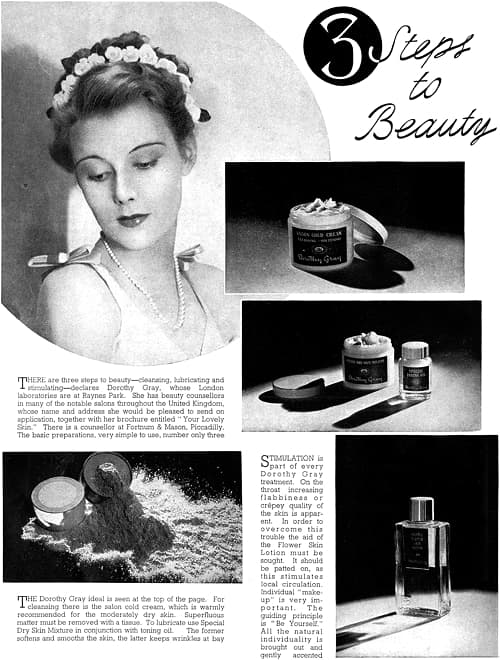
Above: 1939 Dorothy Gray 3 Steps to Beauty (Britain)
The three problem areas and three-step treatments continued right through the 1930s, even as new cleansers and emollients/lubricants were added. New cleansers included: Dorothy Gray Liquid Cleanser (1932); Dorothy Gray Cream 683 (1933), later called Dorothy Gray Dry-Skin Cream; Dorothy Gray Quick Cleansing Lotion (1936); Dorothy Gray Salon Cold Cream (1936); and Dorothy Gray Hot Weather Cleansing Cream (1939) containing ‘refreshing’ mint.
Quick Cleansing Lotion: “A zestful liquid cleanser that cools and stimulates with a pleasant tingling sensation, while it removes dust, perspiration and make-up from the skin. Especially useful … whenever you want to remove and renew your make-up quickly!”
Cream 683: “Dry Skin Cleanser. Contains vegetable oils which double beating breaks up into finest particles, and so makes the cream more than ever thoroughly cleansing. Soothes the dry skin while it cleanses.”
Salon Cold Cream: “A cold cream of salon quality . . . light, fluffy, bland, an exquisite fine-textured emulsion.”
Hot Weather Cleansing Cream: “Very cleansing and refreshing and actually cooling to your skin.”
New emollients/lubricants included: Dorothy Gray Sensitive Skin Cream (1931); and Dorothy Gray Cream Concentrate (1938). The addition of the Sensitive Skin Cream caused the function of Dorothy Gray Special Mixture to change. It had previously been suggested for both dry and sensitive skin but was now renamed/reformulated as Dorothy Gray Special Dry-Skin Mixture, recommended now just for dry skin.
Sensitive Skin Cream: “An unusually delicate preparation, especially prepared as an emollient for the very irritable or sensitive skin, and also for the thin-skinned delicate type of complexion apt to be irritated by a too-rich cream. Soothing to a sunburned or chapped skin. Very bland and light. Very appropriate for a young girl’s skin.”
Special Dry-Skin Mixture: “The softening and lubricating cream, the night cream, for dry skins. Gives the skin rich lubrication and promotes smoothness.”
1-2-3 Salon Facial
In 1933, Dorothy Gray began advertising the 1-2-3 Salon Facial. Women with dry skin were to use Dorothy Gray Cleansing Cream, Special Mixture, and Orange Flower Skin Lotion, while those with oily skins were to combine Dorothy Gray Cleansing Cream, Suppling Cream, and Texture Lotion. The following year, Dorothy Gray combined these products together into Dorothy Gray Salon Facial Packages, the dry skin version packaged in an ivory and black box; the oily skin version in peach and black.
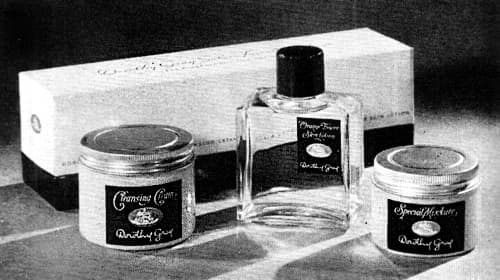
Above: 1934 Dorothy Gray Facial Package for dry skin – Cleansing Cream, Orange Flower Skin Lotion, and Special Mixture.
Dorothy Gray Salon Facial Package
1. Cleanse. In the evening, use Dorothy Gray Cleansing Cream. It floats out deeply embedded dirt, helps prevent blackheads and coarse pores.
2. Lubricate. Then, lubricate with one of Dorothy Gray’s emollient creams. (Special Mixture for dry skins, Suppling Cream for normal and oily skins) Pat it on with the fingers; leave it on overnight to make the skin soft, smooth.
3. Stimulate. Next morning, after cleansing again, pat on a stimulating lotion (Orange Flower Skin lotion for delicate dry skins; Texture lotion for oily skins or coarse pores.) This contracts the pores, refines the texture and brings out the hidden glow.(Dorothy Gray advertisement, 1934)
Vitamins
Like many other cosmetic companies, Dorothy Gray added vitamins to some skin-care cosmetics in the 1930s starting with Extra-Rich Skin Cream. This product had been previously been known as Special Skin Cream and, even earlier, as Special Skin Food. After being renamed/reformulated as Extra-Rich Skin Cream, Vitamin D was added to it in 1937 with vitamin A included as well in 1938. Vitamin D was also added to Dorothy Gray Throat Cream in 1938. It could be used as a throat massaging cream or combined with a chin strap to help keep the throat and neck tissues firm.
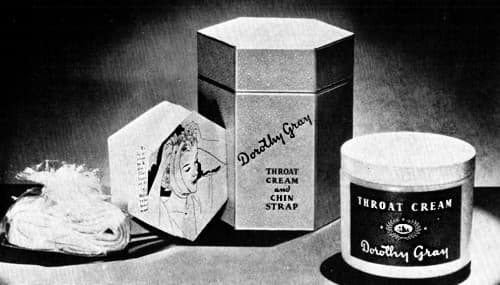
Above: 1936 Dorothy Gray Throat Cream. It could be bought separately or in a package combined with a chin strap.
The last product introduced in the 1930s that contained vitamins was Dorothy Gray Cream Concentrate (1938), a rich night cream formulated with vitamins A & D. It was to be smoothed over lines and wrinkles in conjunction with a regular night cream.
Extra-Rich Skin Cream: “A heavy rich cream specially blended for the care of parched skin requiring particularly effective lubrication … [F]or lined or ageing skins, especially where the face and neck are thin.”
Throat Cream: “Highly effective treatment for massaging crêpy lines on troat and neck. Specially tailored Chin Strap that helps lift and model contour.”
Cream Concentrate: “A multiple strength emollient. Literally a ‘concentrate,’ for it is made almost wholly of the rich emollient extract which usually only occurs only in small quantities in creams. Specially for lined or older faces.”
Other skin-care cosmetics added in the 1930s included: Dorothy Gray Body Rub (1935), a rich, creamy lotion for arms, legs and elbows; and Dorothy Gray Masque Frappé (1935), a rejuvenating mask.
In 1935, Masque Frappé was combined with a cleanser to produce the Dorothy Gray Pick-up Treatment to ‘refresh’ the face before going out in the evening. Like the Dorothy Gray Salon Facial Package, the Pick-up Treatment also came in two forms – dry, and normal to oily. The normal to oily package came with Dorothy Gray Cleansing Cream while the dry skin package contained Dorothy Gray Cream 683.
This tingling cream masque treatment will act like a facial cocktail . . . and bring your beauty back in ten short minutes!
(Dorothy Gray advertisement, 1935)
Outdoor pursuits
Dorothy Gray continued to promote its various sun preparations during the 1930s but also added a few products for colder conditions. For colder climes there was Dorothy Gray Blustery Weather Lotion (1937) and the Dorothy Gray Snow-Bird Twosome (1940) containing Before-You-Ski and After-You-Ski lotions for the snowfields, as well as Dorothy Gray Special Dry-Skin Lotion (1940) and the older Dorothy Gray Cream 683, now called Dorothy Gray Dry-Skin Cleanser, to help with the reduced humidity and dry skin that came with cold winter weather.
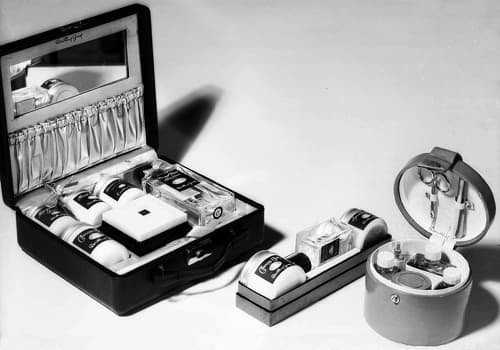
Above: 1934 Dorothy Gray Travel, Facial and Manicure sets.
Make-up
Like many other cosmetic companies Dorothy Gray put a greater emphasis on make-up during the 1930s as revenues from this area increased. The company added new colour cosmetics, expanded its shade ranges, and improved its systems of colour coordination.
Foundations
Dorothy Gray had two finishing preparations (powder bases) available in 1930 – Dorothy Gray Astringent Cream and Dorothy Gray Astringent Lotion, both products having been in the Dorothy Gray inventory for over a decade. The Astringent Lotion left a slight trace of powder on the skin so, for some, may have been all that was needed. Added to these was Dorothy Gray Finishing Lotion (1929) a liquid powder for the face, shoulders, arms, and legs. All three cosmetics continued to be sold through the 1930s but the Astringent Cream was renamed Dorothy Gray Pearly Powder Base, a reflection of its probable vanishing cream base.
See also: Vanishing Creams
By the end of the decade, Dorothy Gray had added three new powder bases – Dorothy Gray Make-up Foundation Cream (1933), Dorothy Gray’s first true tinted foundation in three shades; Dorothy Gray Blustery Weather Lotion (1937), a translucent cream; and Dorothy Gray Elation Make-up Film (1939), a fluffy cream introduced after Elation Powder that only came in one shade, a soft, peachy pink. Both the Foundation Cream, and Blustery Weather Lotion were also promoted as skin protectants, Blustery Weather Lotion particularly so.
Make-up Foundation Cream: “A powder foundation, for all types of skin (except oily skins requiring Astringent lotion). It guards the skin against the drying action of sun and wind.” Shades: White, Natural, and Rachel.
Elation Make-up Film: “A fluffy cream which is easy to apply and makes a perfect foundation for your rouge. Powder clings to it beautifully.” Shades: A soft peach pink later called Natural, with Suntone available in 1943.
Blustery Weather Lotion: “A lovely creamy emulsion that helps against chapping, roughness, redness, dryness. … Boon to sportswomen, for face arms, legs, body rub.
The Dorothy Gray Finishing Lotion also had its shade range updated. When it debuted in 1929 it came in Blonde, Natural, Rachel, Aureate, Orchid, Sunburn, and Tawny shades but, a decade later, this had become Natural, Rachel, Suntone, Aureate, and Coppertan, a reflection of a move to darker skin tones in the intervening time.
The Astringent Cream was kept as a transparent powder base after it was renamed as Dorothy Gray Pearly Powder Base – described as suitable for all skins except those that were very dry – with Dorothy Gray Astringent Lotion suggested as a powder base for individuals with oily skin.
Face Powder
At the end of the 1920s, Dorothy Gray sold three face powders – Dorothy Gray Day Powder, Jacqueminot Powder, and Extra Heavy Powder. All were replaced in the 1930s with new entrants: Dorothy Gray Salon Face Powder (1933) which came in two varieties – Transparent, and Opaque; Dorothy Gray Elation Face Powder (1937), a superfine powder which came in the same shades as the Salon Face Powder; and Dorothy Gray Portrait Face Powder (1938), a slightly tackier powder containing an emollient.
Salon Face Powder: “The very same impalpably-fine powder used in Dorothy Gray Salons. Cannot clog pores. Shades: Cream, Natural, Rachel, Aureate, Tawny Rachel, Suntone, and Evening. Later shades were Coppertan (1936), and Glo-Rachel and Special Blend (1938).
Elation Face Powder: “Perfumed with the exquisite Elation Fragrance … and of exquisite quality and fineness in every detail.” Shades: Cream, Natural, Rachel, Aureate, Tawny Rachel, Suntone, and Evening.
Portrait Face Powder: “Ideally suited to the most sensitive skin. … [P]rotective in application, as it contains just enough of an emollient ingredient for clinging smoothness—it is fluffy as can be and giving the skin a fragile bloom, but with no obvious covering effect.” Shades: Aureate, Coppertan, Cream, Natural, Rachel, Roseglow, Suntone, and Tawny Rachel. Later shades: Glo-Rachel, and Special Blend (1938), Angel Pink (1939), and South American (1940).
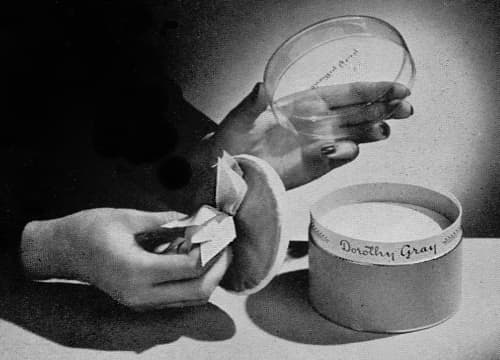
Above: 1939 Dorothy Gray Dusting Powder.
Lipstick and rouge
By 1930, Dorothy Gray had introduced Dorothy Gray Cream Rouge in a range of shades.
Cream Rouge: “[H]as a wonderful way of looking so natural that the color really seems to come from beneath the surface of your skin. And it’s delightfully easy to apply because it is neither sticky nor greasy, but it is exquisitely creamy so that it smooths in lightly, and stays on.” Shades: Light, Medium, Scarlet, Dark, and Tawny with Blush, and Flamingo shades added in 1931.
Tawny was also added to Dorothy Gray Compact Rouge which now also came in five shades – Avis, Sunset, Rouge d’Espagne, Medium, and Tawny.
In 1932, Dorothy Gray introduced a new automatic lipstick and followed this with a new swivel lipstick in 1933. Both lipsticks came in eight shades – Tawny, Sunset, Flamingo, Scarlet, Blush, Avis, Bright Rose, and d’Espagne – and were matched with Dorothy Gray Cream and Compact Rouges which had their shade ranges extended to eight.
This situation remained until 1937 when Dorothy Gray introduced its first new lipstick and matching rouge shade for many years – Royalty Red. After this, the company then began adding new matching lipstick and rouge shades on a regular basis including: Hawaii, Siren, and Plum (1938); Daredevil, Plum Pastel, and Sierra Gold (1939); Cockade, Firelight Red, Ripe Cherries, and South American Red (1940); and All Clear Red, Nosegay, Brass Band, and Nut Brown Red (1941).
Not all lipstick and rouge shades were matched. For example, Dorothy Gray Innocence Cream Rouge (1936) did not come with a corresponding lipstick, and Dorothy Gray Boudoir Rouge (1935), a larger compact rouge was only available in eight shades.
Boudoir Rouge: “[A] fine cake rouge in a big dressing-table size.” Shades: Flamingo, Sunset, Tawny, Scarlet, Blush, Bright Rose, Apis, and d’Espagne.
Innocence Cream Rouge: “For those who don’t like to look made up, gives a faint unsuspected blush.” Shade: Innocence.
Eye make-up
Early Dorothy Gray eye pencils, mascaras, and eye-shadows originally came in a very limited range of shades like Light-Brown, Gray, Blue-Brown, or Black.
Dorothy Gray added Liquid Lashique to its inventory in 1930 and appears to have reformulated the Dorothy Gray Lashique, a block/cake mascara in 1931. The new Lashique was non smarting so may have had the soap in the formulation replaced with triethanolamine.
Liquid Lashique: “It is absolutely waterproof, runproof, smudgeproof and remains unaffected by either tears or swimming. It will not dry of break the lashes.” Shades: Black, and Brown.
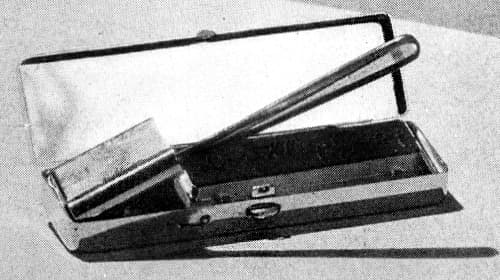
Above: 1934 Dorothy Gray Purse Mascara in silvertone box in Black, Brown, Green, Rose, and Midnight Blue shades.
Also see: Cake Mascara
In 1931, Dorothy Gray Eye Shadow was also reformulated, packaged in a new container, with two new colours – Violet, and Green – added to the earlier shade range.
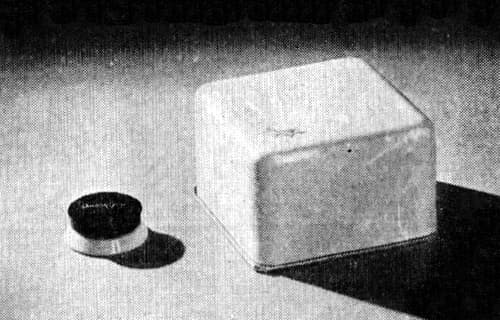
Above: 1931 New Dorothy Gray Eye Shadow and Powder Box containers.
An iridescent eye shadow in four shades – Blue, Green, Violet, and Grey – was added in 1935.
Nail-care
In the 1920s, Dorothy Gray had sold a nail polish under the name Chan Wah Poli but it is possible that it was discontinued by 1929. However, even if this was the case, a newly formulated Dorothy Gray Nail Polish and Remover was introduced in 1931. The nail polish was reformulated again in 1934 by which time it was available in seven shades. Surprisingly, they do not appear to have been well colour coordinated with Dorothy Gray Lipsticks until 1940.
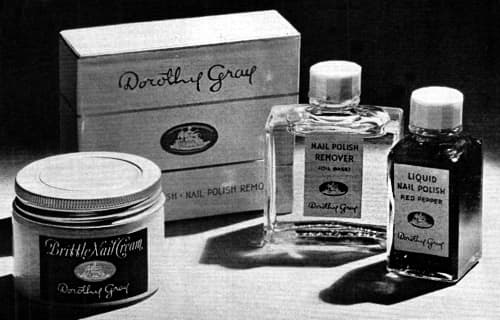
Above: 1934 Dorothy Gray Brittle Nail Cream, Nail Polish, and Nail Polish Remover.
Colour coordination
By 1933, Dorothy Gray had eight shades of matching lipsticks and rouges, a foundation in three shades and Dorothy Gray Salon Face Powder in seven shades. The company then introduced a colour coordination system based on eight skin tones matched with one of the eight shades of lipstick and rouge Dorothy Gray then sold.
Time after time one sees charts of various types which are supposed to tell all about the type one is and the proper make-up for that type. But the disturbing thing is that most of us, average and blended types that we are, seldom fit into these definite “brunettes,” “blondes,” “Titians” and stuff. … [Dorothy Gray has] studied thousands of American types, and finally evolved eight definite skin tones into one of which everybody fits. … And since the Dorothy Gray cosmetics are all planned to complement these tones it is a simple matter to choose your make-up and be at ease.
(Dorothy Gray advertorial, 1933)
To help clients select the right shade of powder, lipstick and rouge, Dorothy Gray placed a colour-coordination device in the shape of a fan on store counters. The fan was placed against the throat or the hollow of the shoulder blade to determine the correct client’s skin tone. Then, the rouge and lipstick indicated by the nearest red panel of the fan selected the perfect complementary make-up.
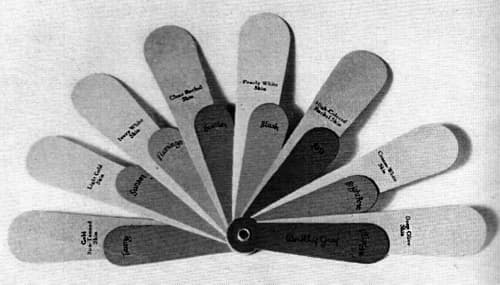
Above: 1933 Dorothy Gray Make-up Fan with eight skin types matched with lipstick and rouge: Gold Sun Tanned Skin with Tawny lipstick and rouge, Light Gold Skin with Sunset; Ivory White Skin with Flamingo; Clear Rachel Skin with Scarlet; Pearly White Skin with Blush; High-Colored Rachel Skin with Avis; Cream White Skin with Bright Rose; and Deep Olive Skin with d’Espagne.
With some slight modifications, Dorothy Gray continued to use this eight-fold system through the rest of the decade.
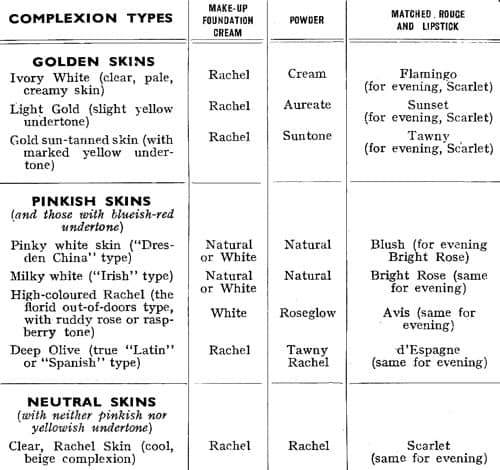
Above: 1939 Dorothy Gray chart to harmonise powder, rouge and lipstick (Britain). The chart came with the following proviso: “Sunlight gives the skin colour. If you apply your daytime make-up in dim surroundings, or under artificial lights, apply it sparingly, for when you go outdoors, the natural daylight will intensify the colour you have applied … On the other hand, artificial lights tend to wipe colour out, reduce the reds in skin and make-up. Note that the delicately-coloured types of skin need to use brighter and deeper cosmetic shades at night“ (Dorothy Gray, 1939, p. 20).
Dorothy Gray does not appear to have systematically harmonise its lipstick, rouge and face powder with nail polish until 1940. In February, 1940, Peggy Sage harmonised twelve shades of its nail polish with lipsticks from seven other cosmetic houses including Dorothy Gray. The following month, Dorothy Gray launched a series of boxed sets called Cosmetic Color Cue. These combined a Dorothy Gray Lipstick with a Dorothy Gray Nail Polish and a harmonised Dorothy Gray Elation Face Powder. From here on, most new shades of Dorothy Gray lipsticks and rouges also came with a matching Dorothy Gray Nail Polish.
Also see: Peggy Sage (post 1940)
Youth market
In 1940, Dorothy Gray targeted college students with Salon Cold Cream, South American Red Lipstick and Special Dry-Skin Lotion none of which were specially formulated for younger, problem skins. In 1942, this was followed with the Dorothy Gray Pretty Fresh Kit containing Dorothy Gray Salon Cold Cream, Hygienic Lotion, Cleansing Grains, and Hygienic Pore Paste. Again, most of these cosmetics had been available for some time and were not specific for teenagers.
New President
In 1941, Joseph Keho was elected to be the new president of Dorothy Gray. He had been hired by Lehn & Fink in 1933 to direct the affairs of Tussy Cosmetiques (Lesquendieu), a company Lehn & Fink bought in 1929. He had previously worked as for Harriet Hubbard Ayer, C. B. Woodworth, and Helena Rubinstein. In 1936, he took on the role of sales manager for Dorothy Gray in addition to Tussy, becoming vice-president and general manager of Dorothy Gray soon after. In 1945, as men returned from the war, he relinquished his management of Tussy and thereafter was solely concerned with Dorothy Gray.
War
America entered the Second World War in December, 1941. By then, Dorothy Gray’s European salons had been cut off and trade with Britain had become very difficult. The American isolation after 1939 may have been part of the reason why Dorothy Gray began using the ‘American Design of Beauty’ slogan in its advertising across the United States. It continued to do so through to 1946.
In the United States, supplies of raw materials for cosmetics and their packaging became difficult after 1941 but the company still managed to introduce a number of new lipstick shades including Crimson Glory, Smiling Red, and Red Letter Red (1942); Headline Red (1943); and Fashion Red, Fuschia Hat, and Frenchman’s Red (1944).
Many of these new lipsticks were packaged in cardboard or other materials not essential for the war effort. However, in 1944, Dorothy Gray was able to reintroduce metal lipstick cases by using metal not suited for the war effort. It was one of the first American cosmetic company to do so.
Other new make-up items included: Dorothy Gray Leg Show (1942), for women finding it difficult to source real stockings; Nosegay Face Powder (1942); and Finisheen Cream (1944), a foundation in four shades.
Leg Show: “Cover your legs with this liquid glamour and give them a sun-burnished tan.” Shades: Special Blend, and Suntone.
Nosegay Face Powder: “ Exquisitely fine . . . spreads lightly, covers smoothly without showing, and clings! Free of ingredients generally suspected of arousing allergies.” Shades: Natural, Special Blend, Rachel, Glo-Rachel, South American, and Suntone.
Finisheen Cream: “Gives the skin a young delicate sheen, a finished look glowing and lasting.” Shades: Natural, Glo-Rachel, Special Blend, and Suntone.
See also: Cosmetic Stockings
In 1943, Dorothy Gray also added a four cosmetics for babies packaged together in a box which presaged the post-war baby boom. The box contained an antiseptic baby oil containing lanolin to cleanse and lubricate a baby’s skin; a baby softening cream to help soften and remove skin scales on the scalp; a baby anti-chafing ointment; and a baby powder made without borax.
In 1944, Dorothy Gray added Dorothy Gray Cellogen Cream, its first hormone cream. This was very late in the day with many other companies entering this market in the 1930s. Cellogen Cream was formulated with 10,000 International Units (I.U.s) per ounce of natural estrogens, the maximum allowed by the American Food and Drug Administration (FDA).
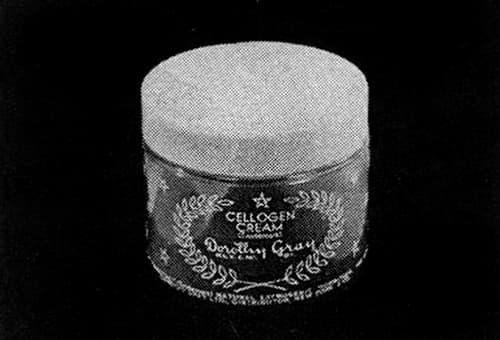
Above: 1944 Dorothy Gray Cellogen Cream.
Cellogen Cream: “[T]o help your skin grow smoother, brighter, clearer looking. Contains a glandular young skin ingredient which skins over thirty often lack.”
See also: Hormone Creams, Oils and Serums
Timeline
| 1930 | Dorothy Gray S.A. established in France. Paris salon opened at 34 Avenue George V. New Products: Skyscraper Compact; Cream Rouge; and Liquid Lashique. |
| 1931 | Part time physician in attendance at some Dorothy Gray salons. New Products: Sensitive Skin Cream. |
| 1932 | Dorothy Gray opens first ship-board salon on the Grace Ship the Santa Rosa. New Products: Liquid Cleansing Cream. |
| 1933 | New Products: Cream 683; Make-up Foundation Cream; and Salon Face Powder. |
| 1935 | New Products: Boudoir Rouge. |
| 1936 | Dorothy Gray Ltd. founded in London. London salon opened in Hanover Square. New Products: Salon Cold Cream; Throat Cream; Pore Grains; and Innocence Cream Rouge. |
| 1937 | Dorothy Gray Salons Company established in London. New Products: Blustery Weather Lotion. |
| 1938 | Exercise department added to the New York salon. New Products: Cream Concentrate; and Portrait Face Powder. |
| 1939 | New Products: Elation Make-up Film; and Hot Weather Cleansing Cream. |
| 1940 | New Products: Dry-Skin Lotion; Before-You-Ski Lotion; and After-You-Ski Lotion. |
| 1942 | New Products: Leg Show. |
| 1943 | New Products: Nosegay Face Powder; and baby products. |
| 1944 | New Products: Cellogen Cream; and Finisheen Cream. |
Continued onto: Dorothy Gray (post 1945)
First Posted: 14th October 2010
Last Update: 23rd July 2021
Sources
Dorothy Gray. (1939). Your lovely skin [Booklet]. Great Britain: Author.
Lehn & Fink. Annual Reports 1929-1964.
The man behind the scenes. (1932) Dry goods economist. New York: Textile Publishing Company.
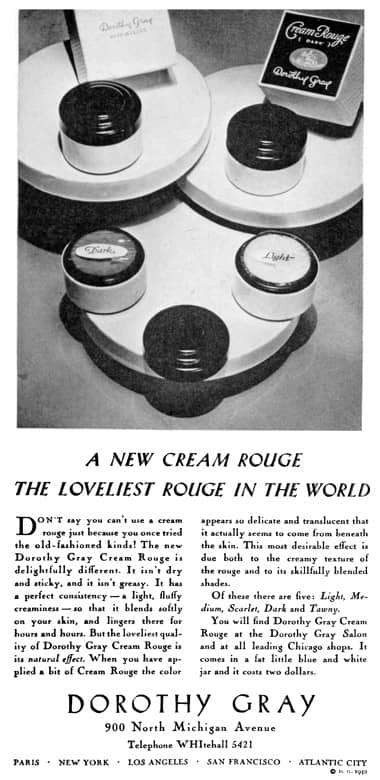
1930 Dorothy Gray Cream Rouge.
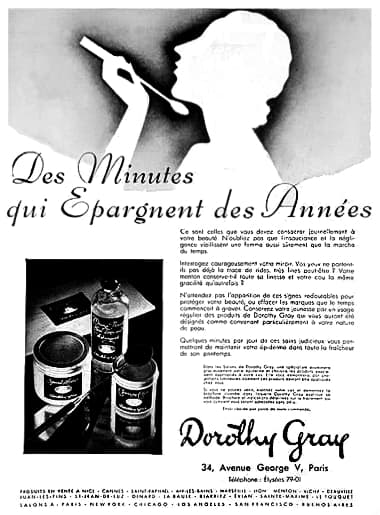
1931 Dorothy Gray (France).
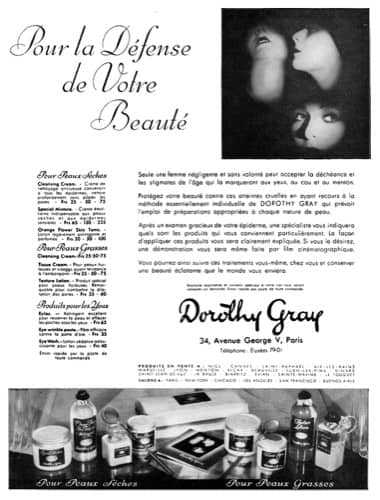
1931 Dorothy Gray (France).
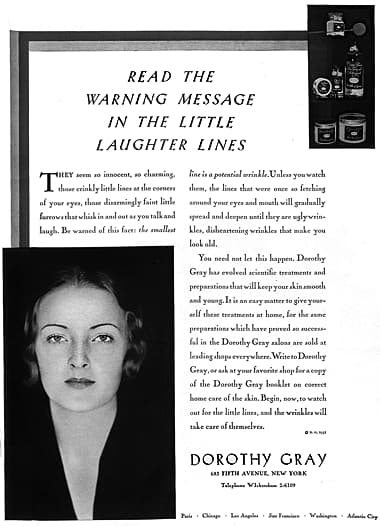
1931 Dorothy Gray warning message in the little laughter lines.
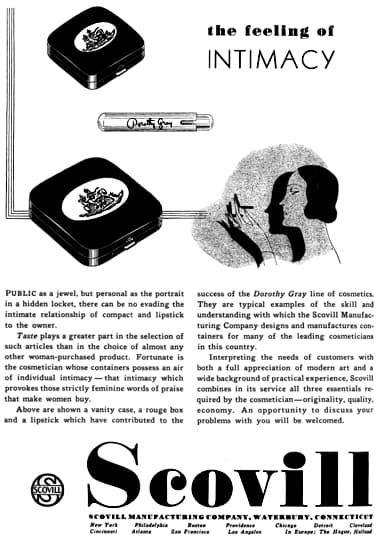
1931 Scoville compacts and lipsticks for Dorothy Gray.
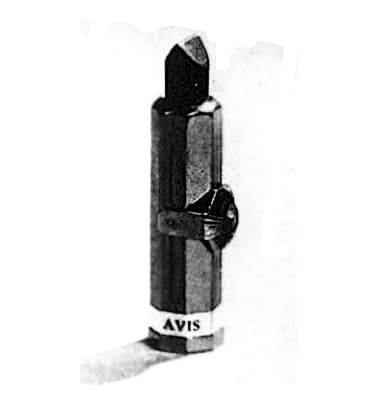
1932 Dorothy Gray Automatic Lipstick. The Avis shade was named after Dorothy Gray’s younger sister.
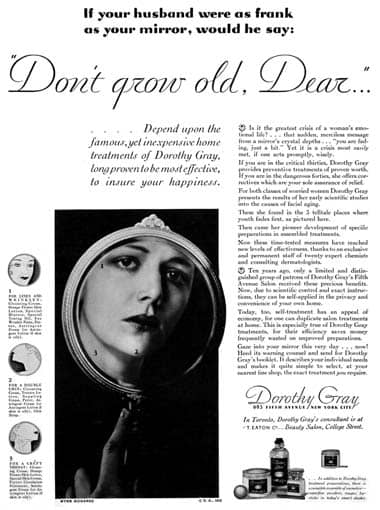
1932 Dorothy Gray three telltale places where youth fades first – lines and wrinkles, double chin, and crêpy throat.
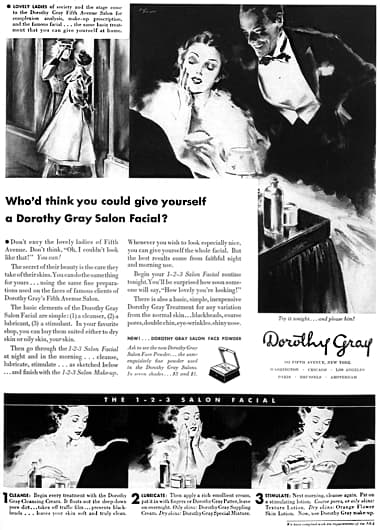
1933 Dorothy Gray Salon Facial.
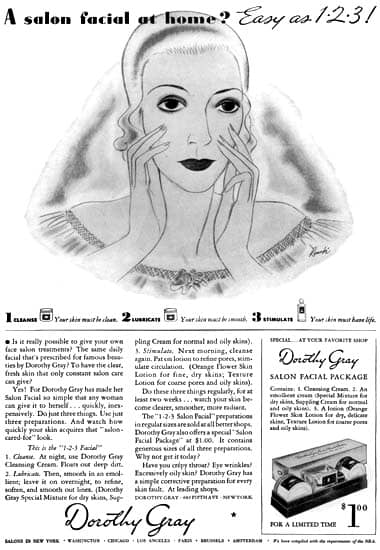
1934 Dorothy Gray Salon Facial Package.
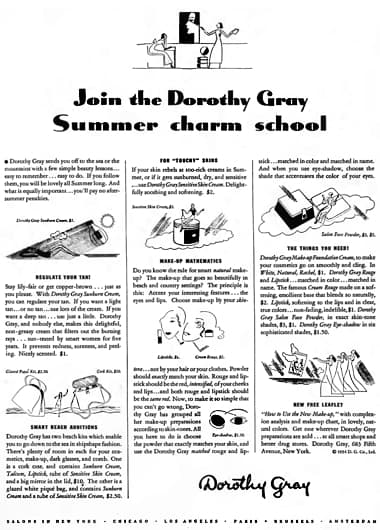
1934 Dorothy Gray Summer Charm School.
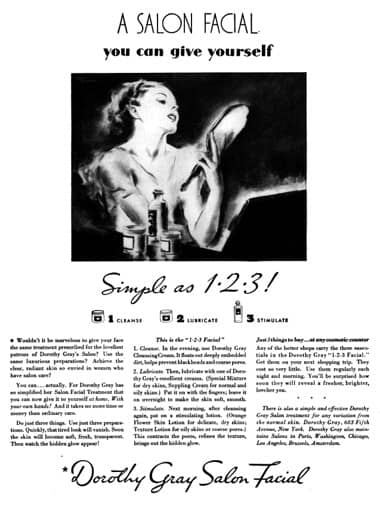
1934 Dorothy Gray Salon Facial: Cleanse, Lubricate, Stimulate.
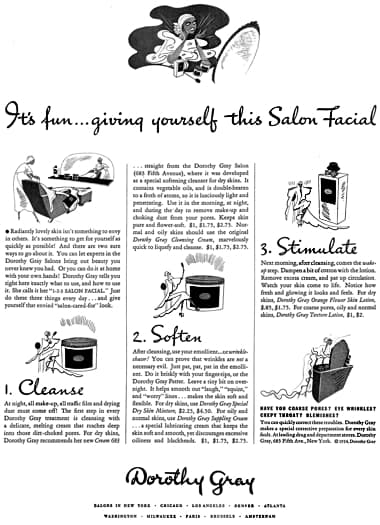
1934 Dorothy Gray Salon Facial: Cleanse, Soften, Stimulate.
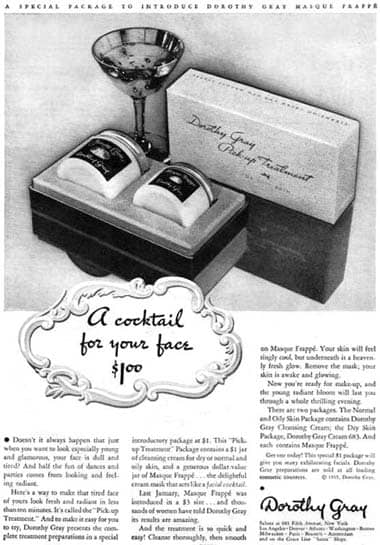
1935 Dorothy Gray Pick-up Treatment.
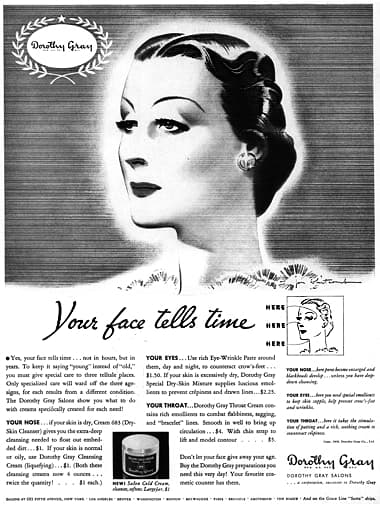
1936 Dorothy Gray your face tells time.
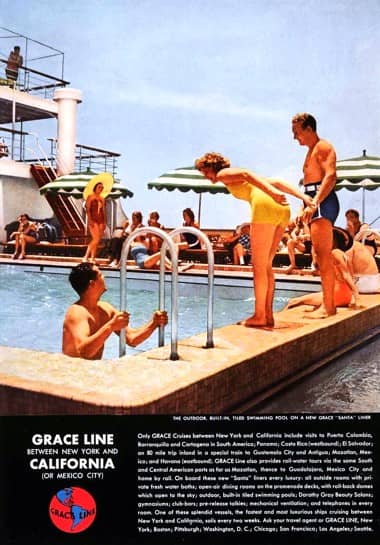
1936 The Grace Line. The first ship-board Dorothy Gray salon was installed on the S.S. Santa Rosa ship of the Grace line in 1932.
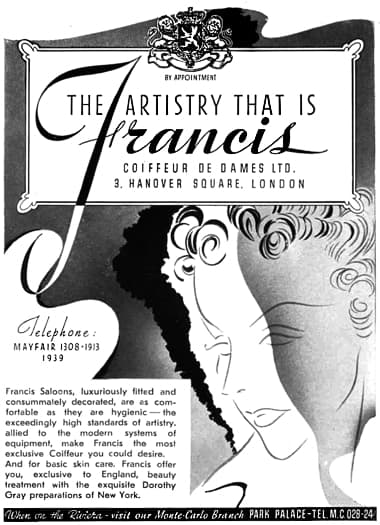
1937 Dorothy Gray salon in Francis Coiffure de Dames, Hanover Square, London.
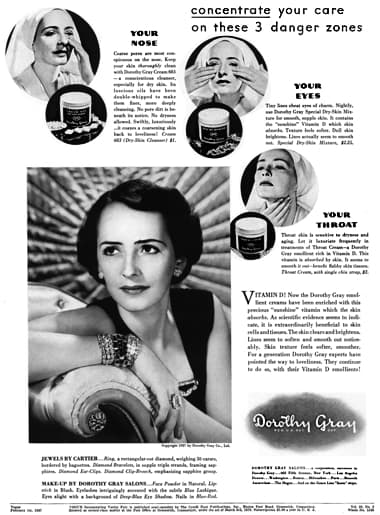
1937 Dorothy Gray danger zones.
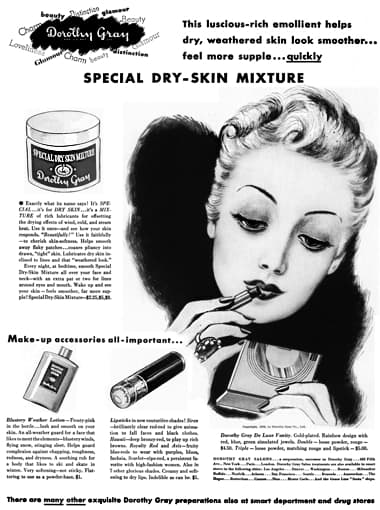
1938 Dorothy Gray Special Dry-Skin Mixture.
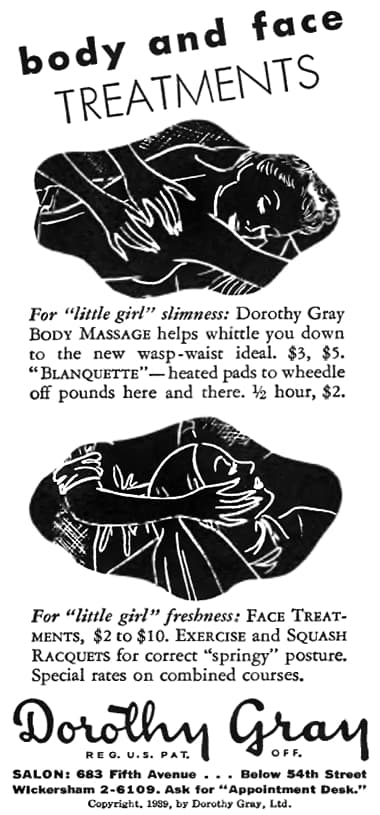
1939 Dorothy Gray salon treatments.
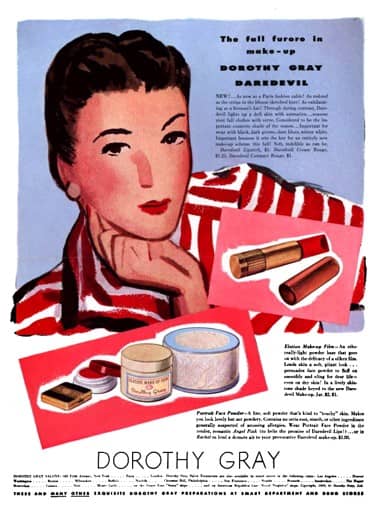
1939 Dorothy Gray Daredevil fall colour scheme. As with other Dorothy Gray lipsticks, the colours came in matching cream and compact rouge. Elation Make-up Film was used as a powder base and then Portrait Face Powder in shades of Angel Pink or Rachel complete the colour combination. Clothing colours of black, dark greens, slate blues or winter whites were suggested for maximum effect.
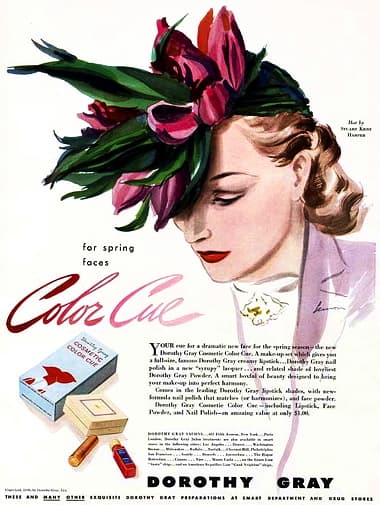
1940 Dorothy Gray Color Cue which harmonised lipstick, nail polish and face powder.
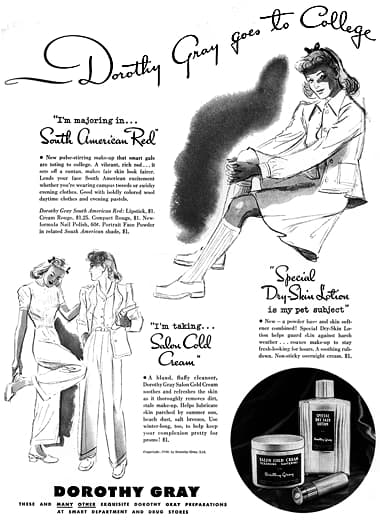
1940 Dorothy Gray Goes to College. Products aimed at a younger market: South American Red lipstick and rouge; Salon Cold Cream; and Special Dry-Skin Lotion.
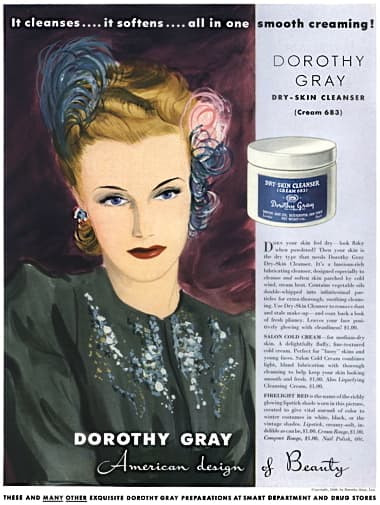
1940 Dorothy Gray Dry-Skin Mixture.
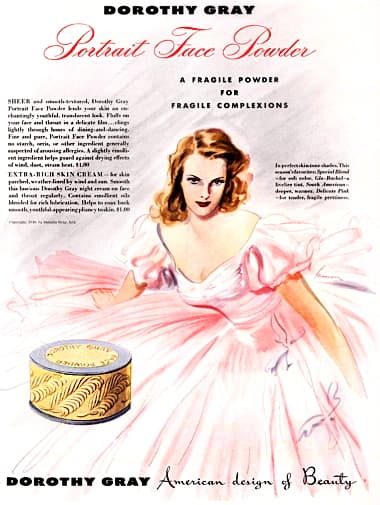
1940 Dorothy Gray Portrait Face Powder.

1940 Dorothy Gray Personality Styling.
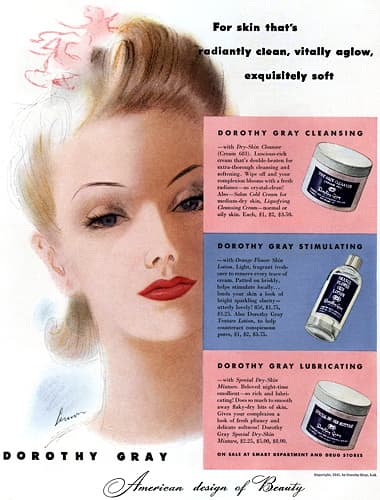
1941 Dorothy Gray. The three step routine has now become ‘Cleanse, Stimulate, Lubricate’.
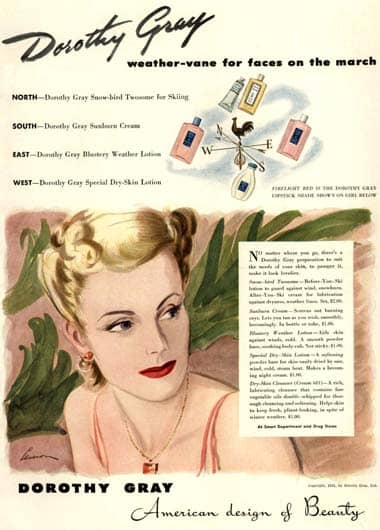
1941 Weather-vane for faces on the march by Dorothy Gray. Skin care for all weather conditions.
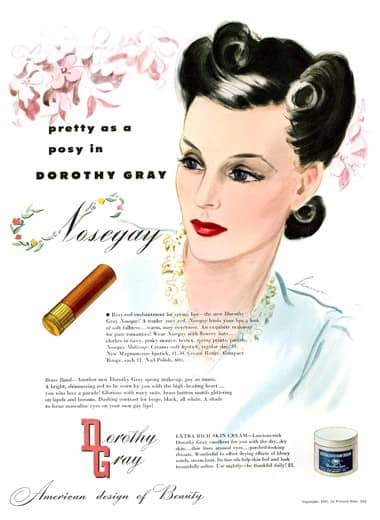
1941 Dorothy Gray Nosegay. In 1938, Dorothy Gray debuted a new perfume called Nosegay followed by a number of cosmetics.
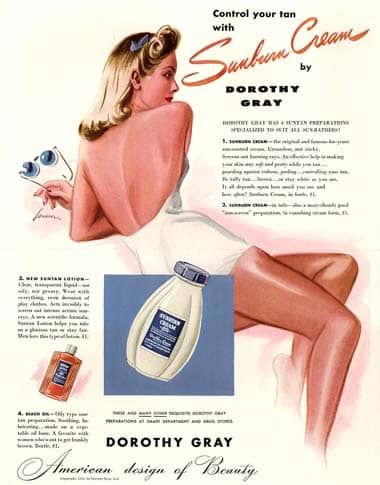
1941 Dorothy Gray Sunburn Cream.
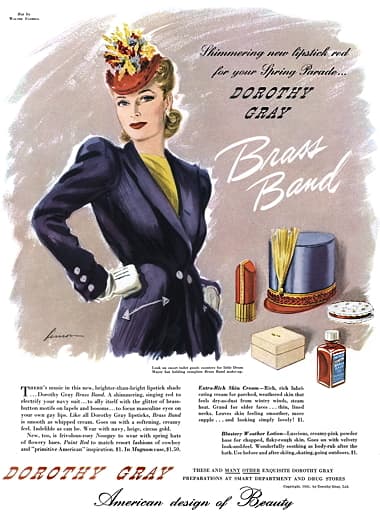
1941 Dorothy Gray Brass Band Lipstick.
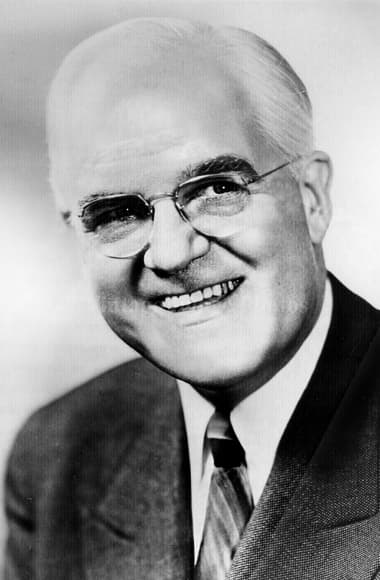
Joseph Keho [1888-1976] a.k.a. Joseph James Keough. He married Ethel McCormick [1887-1945] in 1908.
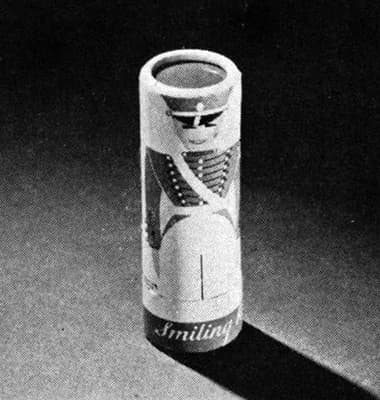
1942 Dorothy Gray Smiling Red Lipstick packaged in a cardboard case.
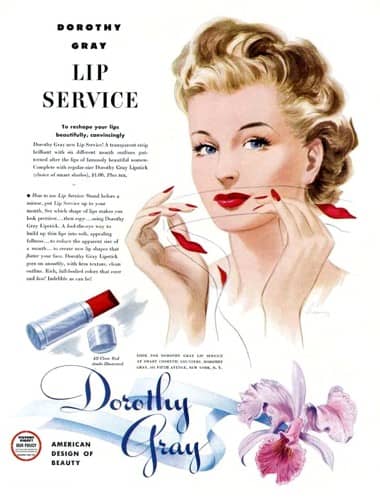
1942 Dorothy Gray Lip Service.
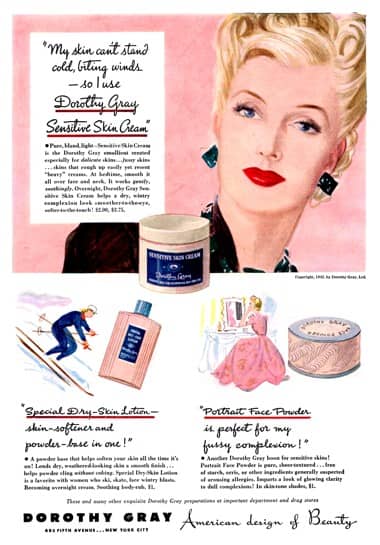
1942 Dorothy Gray Sensitive Skin Cream first introduced in 1931.
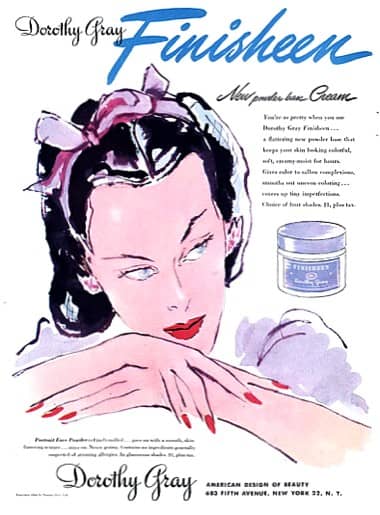
1944 Dorothy Gray Finisheen Cream Foundation.
